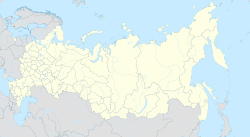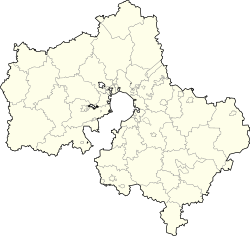world.wikisort.org - Russia
Sergiyev Posad (Russian: Се́ргиев Поса́д, IPA: [ˈsʲɛrgʲɪ(j)ɪf pɐˈsat]) is a city and the administrative center of Sergiyevo-Posadsky District in Moscow Oblast, Russia. Population: 111,179 (2010 Census);[4] 113,581 (2002 Census);[9] 114,696 (1989 Census).[10]
Sergiyev Posad
Сергиев Посад | |
|---|---|
City[1] | |
 Central part of the city | |
 Flag  Coat of arms | |
Location of Sergiyev Posad  | |
 Sergiyev Posad Location of Sergiyev Posad  Sergiyev Posad Sergiyev Posad (Moscow Oblast) | |
| Coordinates: 56°18′N 38°08′E | |
| Country | Russia |
| Federal subject | Moscow Oblast[1] |
| Administrative district | Sergiyevo-Posadsky District[1] |
| City | Sergiyev Posad[1] |
| Founded | 1347 |
| City status since | 1782 |
| Government | |
| • Body | Council of Deputies[2] |
| Area | |
| • Total | 50.40 km2 (19.46 sq mi) |
| Elevation | 210 m (690 ft) |
| Population | |
| • Total | 111,179 |
| • Estimate (2018)[5] | 103,444 (−7%) |
| • Rank | 142nd in 2010 |
| • Density | 2,200/km2 (5,700/sq mi) |
Administrative status | |
| • Capital of | Sergiyevo-Posadsky District[1], City of Sergiyev Posad[1] |
Municipal status | |
| • Municipal district | Sergiyevo-Posadsky Municipal District[6] |
| • Urban settlement | Sergiyev Posad Urban Settlement[6] |
| • Capital of | Sergiyevo-Posadsky Municipal District[6], Sergiyev Posad Urban Settlement[6] |
| Time zone | UTC+3 (MSK |
| Postal code(s)[8] | 141300–141315, 141318 |
| Dialing code(s) | +7 496 |
| OKTMO ID | 46728000001 |
| Website | www |
It was previously known as Sergiyev Posad (until 1919), Sergiyev (until 1930), Zagorsk (until 1991).
History

Sergiyev Posad grew in the 15th century around one of the greatest of Russian monasteries, the Trinity Lavra established by St. Sergius of Radonezh, still (as of 2015[update]) one of the largest monasteries in Russia.[citation needed] Town status was granted to Sergiyev Posad in 1742.[citation needed] The town's name, alluding to St. Sergius, has strong religious connotations. Soviet authorities changed it first to just Sergiyev in 1919, and then to Zagorsk in 1930, in memory of the revolutionary Vladimir Zagorsky.[11] Sergiyev Posad wasn't penetrated by Germany in 1941.[citation needed]
The original name was restored in 1991.[citation needed]
Administrative and municipal status
Within the framework of administrative divisions, Sergiyev Posad serves as the administrative center of Sergiyevo-Posadsky District.[1] As an administrative division, it is, together with twenty-six rural localities, incorporated within Sergiyevo-Posadsky District as the City of Sergiyev Posad.[1] As a municipal division, the City of Sergiyev Posad is incorporated within Sergiyevo-Posadsky Municipal District as Sergiyev Posad Urban Settlement.[6]
Culture
Due to the nature of this city and proximity to Kelarsky pond, art and culture has been integrated with this city and Numerous museums and palaces exists in this region, such as the Museum of Soviet childhood, the Pavel Florensky Museum, the Museum of toys. In addition, it is home to many such as which has been mentioned in War and Peace, Yuri Gagarin Palace of Culture which is a Russian Heritage Building
- Street in Sergiyev Posad by Aristarkh Lentulov
- Kelarsky pond
- Lavra Hotel
 Yuri Gagarin Palace of Culture
Yuri Gagarin Palace of Culture- Moscow Theological Academy
Economy
Tourism associated with the Golden Ring plays a role in the regional economy. There is also an important toy factory.
Transportation
The Moscow–Yaroslavl railway and highway pass through the town. Sergiyev Posad Bus Terminal is located in the city.
Notable people
- Andrei Rublev, artist, Church iconography, lived in the 14-15th centuries, author of Saint Trinity's icon.
- Daniel Chorniy, artist, Church icononography, lived in the 14-15th centuries.
- Pavel Florensky, Russian Orthodox theologian and researcher
- Vikentii Trofimov, painter
- Vladimir Favorsky, graphic artist, woodcut illustrator, painter[12]
- Aristarkh Lentulov, avant-garde artist
- Boris Kustodiev, painter.
- Mikhail Nesterov, painter.
Twin towns – sister cities
Sergiyev Posad is twinned with:[13]
 Cephalonia, Greece
Cephalonia, Greece Fulda, Germany
Fulda, Germany New Athos, Georgia
New Athos, Georgia Rueil-Malmaison, France
Rueil-Malmaison, France Saldus, Latvia
Saldus, Latvia Slonim, Belarus
Slonim, Belarus Vagharshapat, Armenia
Vagharshapat, Armenia
Former twin towns:
 Gniezno, Poland
Gniezno, Poland
In March 2022, the Polish city of Gniezno severed its ties with Sergiyev Posad as a response to the 2022 Russian invasion of Ukraine.[14]
References
Notes
- Resolution #123-PG
- "Администрация городcкого поселения Сергиев Посад | Устав городского поселения Сергиев Посад Сергиево-Посадского муниципального района Московской области". Archived from the original on February 21, 2018. Retrieved June 11, 2015.
- Росстат. Регионы России. Основные социально-экономические показатели городов. 2010 г.
- Russian Federal State Statistics Service (2011). Всероссийская перепись населения 2010 года. Том 1 [2010 All-Russian Population Census, vol. 1]. Всероссийская перепись населения 2010 года [2010 All-Russia Population Census] (in Russian). Federal State Statistics Service.
- "26. Численность постоянного населения Российской Федерации по муниципальным образованиям на 1 января 2018 года". Federal State Statistics Service. Retrieved January 23, 2019.
- Law #60/2005-OZ
- "Об исчислении времени". Официальный интернет-портал правовой информации (in Russian). June 3, 2011. Retrieved January 19, 2019.
- Почта России. Информационно-вычислительный центр ОАСУ РПО. (Russian Post). Поиск объектов почтовой связи (Postal Objects Search) (in Russian)
- Russian Federal State Statistics Service (May 21, 2004). Численность населения России, субъектов Российской Федерации в составе федеральных округов, районов, городских поселений, сельских населённых пунктов – районных центров и сельских населённых пунктов с населением 3 тысячи и более человек [Population of Russia, Its Federal Districts, Federal Subjects, Districts, Urban Localities, Rural Localities—Administrative Centers, and Rural Localities with Population of Over 3,000] (XLS). Всероссийская перепись населения 2002 года [All-Russia Population Census of 2002] (in Russian).
- Всесоюзная перепись населения 1989 г. Численность наличного населения союзных и автономных республик, автономных областей и округов, краёв, областей, районов, городских поселений и сёл-райцентров [All Union Population Census of 1989: Present Population of Union and Autonomous Republics, Autonomous Oblasts and Okrugs, Krais, Oblasts, Districts, Urban Settlements, and Villages Serving as District Administrative Centers]. Всесоюзная перепись населения 1989 года [All-Union Population Census of 1989] (in Russian). Институт демографии Национального исследовательского университета: Высшая школа экономики [Institute of Demography at the National Research University: Higher School of Economics]. 1989 – via Demoscope Weekly.
-
Compare: Ring, Trudy; Watson, Noelle; Schellinger, Paul, eds. (1996). "Sergiev (Moscow, Russia)". Northern Europe: International Dictionary of Historic Places. Routledge (published 2013). ISBN 9781136639517. Retrieved August 8, 2015.
Lenin's successor Stalin intensified religious persecution in the Soviet Union overall, and the situation perhaps became threatening enough to warrant the town to change its name in 1930 to Zagorsk, derived from the name of the Bolshevik revolutionary Vladimir Zagorsky, who was assassinated by rival socialists in 1919.
- Great Soviet Encyclopedia (3rd ed., 1977), vol. 27, p. 178
- "Побратимы Сергиева Посада". sergiev.ru (in Russian). Sergiev.ru. Retrieved February 4, 2020.
- "Gniezno zrywa umowę partnerską z rosyjskim miastem Siergijev Posad" (in Polish). Retrieved March 13, 2022.
Sources
- Губернатор Московской области. Постановление №123-ПГ от 28 сентября 2010 г. «Об учётных данных административно-территориальных и территориальных единиц Московской области», в ред. Постановления №252-ПГ от 26 июня 2015 г. «О внесении изменения в учётные данные административно-территориальных и территориальных единиц Московской области». Опубликован: "Информационный вестник Правительства МО", №10, 30 октября 2010 г. (Governor of Moscow Oblast. Resolution #123-PG of September 28, 2010 On the Inventory Data of the Administrative-Territorial and Territorial Units of Moscow Oblast, as amended by the Resolution #252-PG of June 26, 2015 On Amending the Inventory Data of the Administrative-Territorial and Territorial Units of Moscow Oblast. ).
- Московская областная Дума. Закон №60/2005-ОЗ от 28 февраля 2005 г. «О статусе и границах Сергиево-Посадского муниципального района и вновь образованных в его составе муниципальных образований», в ред. Закона №161/2011-ОЗ от 14 октября 2011 г. «О внесении изменений в Закон Московской области "О статусе и границах Сергиево-Посадского муниципального района и вновь образованных в его составе муниципальных образований"». Вступил в силу со дня официального опубликования. Опубликован: "Ежедневные Новости. Подмосковье", №42, 10 марта 2005 г. (Moscow Oblast Duma. Law #60/2005-OZ of February 28, 2005 On the Status and the Borders of Sergiyevo-Posadsky Municipal District and the Newly Established Municipal Formations Comprising It, as amended by the Law #161/2011-OZ of October 14, 2011 On Amending the Law of Moscow Oblast "On the Status and the Borders of Sergiyevo-Posadsky Municipal District and the Newly Established Municipal Formations Comprising It". Effective as of the day of the official publication.).
Further reading
- Trudy Ring, ed. (1995). "Sergiev". International Dictionary of Historic Places: Northern Europe. Fitzroy Dearborn. ISBN 978-1-136-63944-9.
External links
- Official website of Sergiyev Posad (in Russian)
- Unofficial website of Sergiyev Posad (in Russian)
- Official website of the Sergiyev Posad State History and Art Museum-Reserve (in Russian)
- Official website of the Holy Trinity-St. Sergius Lavra
- Sergiyev Posad travelog
На других языках
[de] Sergijew Possad
Sergijew Possad (russisch Се́ргиев Поса́д), von 1919 bis 1930 Sergijew (Се́ргиев) und von 1930 bis 1991 Sagorsk (Заго́рск), ist eine russische Großstadt mit 111.179 Einwohnern (Stand 14. Oktober 2010)[1] in der Oblast Moskau, 71 km nordöstlich von Moskau. Die Stadt, deren Name so viel wie „Possad des Heiligen Sergius“ bedeutet, ist vor allem durch das dort gelegene, zum UNESCO-Welterbe zählende Dreifaltigkeitskloster bekannt. Hierdurch stellt sie eines der wichtigsten Touristenziele im Moskauer Umland dar und gehört zum sogenannten Goldenen Ring von alten historischen Städten nordöstlich von Moskau.- [en] Sergiyev Posad
[es] Sérguiyev Posad
Sérguiyev Posad (en ruso: Се́ргиев Поса́д, siendo un posad un asentamiento o campamento popular en la Rusia de los siglos X y XV) que entre 1930 y 1991 fue llamada Zagorsk, es una ciudad rusa, al nordeste de Moscú. Como parte del Anillo de Oro de Rusia posee un importante conjunto monumental, el monasterio de la Trinidad y de San Sergio (siglos XV-XVIII), declarado Patrimonio de la Humanidad por la UNESCO.[ru] Сергиев Посад
Се́ргиев Поса́д (в 1930—1991 гг. — Загорск) — город в Московской области России. Административный центр[4] Сергиево-Посадского городского округа Московской области.Другой контент может иметь иную лицензию. Перед использованием материалов сайта WikiSort.org внимательно изучите правила лицензирования конкретных элементов наполнения сайта.
WikiSort.org - проект по пересортировке и дополнению контента Википедии




